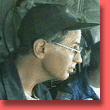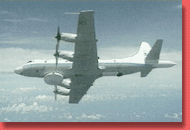| F
r a n k M a r k s
 I am a meteorologist working for NOAA's Hurricane
Research Division in Miami, FL. I have worked here since 1980. I became
interested in meteorology when I was 13 years old. My neighbor was a
science teacher at the local high school and he got me interested through
the instruments he had on his house. He was an amateur meteorologist
and ran a weather club as part of his science class. During the next
5 years I learned how to take observations of the atmosphere, plot the
observations on a map with other data collected around the country,
analyze the observations, and use them to make forecasts of the local
weather. We posted our forecasts at the high school and read them over
the morning announcements.
I am a meteorologist working for NOAA's Hurricane
Research Division in Miami, FL. I have worked here since 1980. I became
interested in meteorology when I was 13 years old. My neighbor was a
science teacher at the local high school and he got me interested through
the instruments he had on his house. He was an amateur meteorologist
and ran a weather club as part of his science class. During the next
5 years I learned how to take observations of the atmosphere, plot the
observations on a map with other data collected around the country,
analyze the observations, and use them to make forecasts of the local
weather. We posted our forecasts at the high school and read them over
the morning announcements.
Convinced
I wanted to be a meteorologist I only applied to colleges that offered
an undergraduate meteorology degree. I ended up going to a small liberal
arts college in New Hampshire (Belknap College) that had an excellent
meteorology program. While I was there I realized that there was more
to meteorology than making forecasts. I became interested in why the
weather behaved the way it did, deciding to continue my education by
getting a graduate degree.
I
applied to a number of graduate schools that offered meteorology degrees
and ended up at MIT after graduating with a BS in meteorology in 1973.
At MIT I received my MS in meteorology in 1975 and ScD in 1980. While
a graduate student I was fortunate enough to participate in the Global
Atmospheric Research Program Atlantic Tropical Experiment (GATE), spending
100 days in Dakar, Senegal during the summer of 1974, and 6 weeks in
Borneo for the Winter Monsoon Experiment (WMONEX) during the winter
of 1978-79. These two experiences were invaluable to setting my future
path as a research meteorologist. By participating in these two experiments
I was able to see first hand how research scientists design and execute
experiments in the field. My experience in GATE and the data collected
was central to my doctoral thesis. Also, the scientists I met during
these experiments became mentors and one eventually offered me the job
I have now.
 The
part of NOAA I work for studies what makes tropical storms do what they
do. We fly in large four-engine turboprop (propeller) aircraft into
the storm. Since 1980 I have flown into 65-70 tropical cyclones, of
which more than 40 were hurricanes, making over 390 penetrations into
hurricane eyes. My first flight was into Hurricane Allen in 1980. Since
then I have flown into Hurricanes Diana in 1984, Elena and Gloria in
1985, Emily in 1987, Gilbert in 1988, Hugo in 1989, Andrew in 1992,
Fran in 1996, Bonnie in 1998, and Dennis and Floyd in 1999 to name the
more recognizable storms. These flights take 9-10 hours, in which time
we fly into the eye 9-10 times (the most was 24 times!) We operate out
of airfields all around the Caribbean and West Atlantic, such as St
Croix, Barbados, and Bermuda. The
part of NOAA I work for studies what makes tropical storms do what they
do. We fly in large four-engine turboprop (propeller) aircraft into
the storm. Since 1980 I have flown into 65-70 tropical cyclones, of
which more than 40 were hurricanes, making over 390 penetrations into
hurricane eyes. My first flight was into Hurricane Allen in 1980. Since
then I have flown into Hurricanes Diana in 1984, Elena and Gloria in
1985, Emily in 1987, Gilbert in 1988, Hugo in 1989, Andrew in 1992,
Fran in 1996, Bonnie in 1998, and Dennis and Floyd in 1999 to name the
more recognizable storms. These flights take 9-10 hours, in which time
we fly into the eye 9-10 times (the most was 24 times!) We operate out
of airfields all around the Caribbean and West Atlantic, such as St
Croix, Barbados, and Bermuda.
|
 I am a meteorologist working for NOAA's Hurricane
Research Division in Miami, FL. I have worked here since 1980. I became
interested in meteorology when I was 13 years old. My neighbor was a
science teacher at the local high school and he got me interested through
the instruments he had on his house. He was an amateur meteorologist
and ran a weather club as part of his science class. During the next
5 years I learned how to take observations of the atmosphere, plot the
observations on a map with other data collected around the country,
analyze the observations, and use them to make forecasts of the local
weather. We posted our forecasts at the high school and read them over
the morning announcements.
I am a meteorologist working for NOAA's Hurricane
Research Division in Miami, FL. I have worked here since 1980. I became
interested in meteorology when I was 13 years old. My neighbor was a
science teacher at the local high school and he got me interested through
the instruments he had on his house. He was an amateur meteorologist
and ran a weather club as part of his science class. During the next
5 years I learned how to take observations of the atmosphere, plot the
observations on a map with other data collected around the country,
analyze the observations, and use them to make forecasts of the local
weather. We posted our forecasts at the high school and read them over
the morning announcements.
 The
part of NOAA I work for studies what makes tropical storms do what they
do. We fly in large four-engine turboprop (propeller) aircraft into
the storm. Since 1980 I have flown into 65-70 tropical cyclones, of
which more than 40 were hurricanes, making over 390 penetrations into
hurricane eyes. My first flight was into Hurricane Allen in 1980. Since
then I have flown into Hurricanes Diana in 1984, Elena and Gloria in
1985, Emily in 1987, Gilbert in 1988, Hugo in 1989, Andrew in 1992,
Fran in 1996, Bonnie in 1998, and Dennis and Floyd in 1999 to name the
more recognizable storms. These flights take 9-10 hours, in which time
we fly into the eye 9-10 times (the most was 24 times!) We operate out
of airfields all around the Caribbean and West Atlantic, such as St
Croix, Barbados, and Bermuda.
The
part of NOAA I work for studies what makes tropical storms do what they
do. We fly in large four-engine turboprop (propeller) aircraft into
the storm. Since 1980 I have flown into 65-70 tropical cyclones, of
which more than 40 were hurricanes, making over 390 penetrations into
hurricane eyes. My first flight was into Hurricane Allen in 1980. Since
then I have flown into Hurricanes Diana in 1984, Elena and Gloria in
1985, Emily in 1987, Gilbert in 1988, Hugo in 1989, Andrew in 1992,
Fran in 1996, Bonnie in 1998, and Dennis and Floyd in 1999 to name the
more recognizable storms. These flights take 9-10 hours, in which time
we fly into the eye 9-10 times (the most was 24 times!) We operate out
of airfields all around the Caribbean and West Atlantic, such as St
Croix, Barbados, and Bermuda.